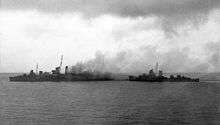Savo Island
| Savo Island | |
|---|---|
 Sketch map of Savo Island (1942), with heights in feet | |
| Highest point | |
| Elevation | 485 m (1,591 ft) |
| Coordinates | 9°8′0″S 159°49′0″E / 9.13333°S 159.81667°ECoordinates: 9°8′0″S 159°49′0″E / 9.13333°S 159.81667°E |
| Geography | |
| Location | Solomon Islands |
| Geology | |
| Mountain type | Stratovolcano |
| Volcanic arc/belt | Bougainville & Solomon Is. |
| Last eruption | 1835 to 1847 (?)[1] |
Savo Island is a volcanic island in Solomon Islands in the South Pacific ocean. It is located to the north of the western tip of Guadalcanal Island at 9°8′0″S 159°49′0″E / 9.13333°S 159.81667°E. Politically, Savo Island is a part of the Solomons' Central Province. The indigenous language of Savo is the Savosavo language.
The volcano of the island last erupted in the years between 1835 and 1850. One eruption was so strong that it wiped out all life on the island. A previous eruption occurred in 1568. According to the data of the World Organization of Volcanic Observatories, Savo Island is active every 100 to 300 years.[2]
European discovery and exploration
The first recorded sighting of Savo Island by European explorers was by the Spanish expedition of Álvaro de Mendaña in April 1568. More precisely the sighting was due to a local exploration voyage done by a small boat, in the accounts the brigantine, commanded by Maestre de Campo Pedro de Ortega Valencia and having Hernán Gallego as pilot. They charted the volcanic island as Sesarga. Considering the expedition leaders Mendaña and cosmographer Pedro Sarmiento de Gamboa were both from Galicia in Spain it was probably so named after the island of the same name in this region.[3][4]
Savo Island in World War II
Because of its proximity to Guadalcanal Island and the hotly contested nature of the battles for control of the Solomon Islands, Savo Island figured in many of the naval engagements of the Solomon Islands campaign. It is most well known as the location of several naval battles fought in the adjacent "Ironbottom Sound" during World War II, between the Allied naval forces and the Imperial Japanese Navy.

List of World War II naval battles fought in the vicinity of Savo Island:
- Battle of Savo Island, 9 August 1942
- Battle of Cape Esperance (originally known as the "Second Battle of Savo Island"), 11–12 October 1942
- Naval Battle of Guadalcanal, 13–15 November 1942
- Battle of Tassafaronga, 30 November 1942
The "egg fields"
Savo Island is also known for the "egg fields" of the megapode, a bird which comes to lay its eggs here and bury them in the sand to incubate, as the sand is warm being a volcanic island. The eggs are then dug out by local people and are considered a local food specialty. The eggs are just a bit bigger than a duck egg and are used for preparing omelettes and other dishes.[5]
See also
- List of volcanoes in the Solomon Islands
- Geography of the Solomon Islands
- History of the Solomon Islands
References
- ↑ "Savo". Global Volcanism Program. Smithsonian Institution. Retrieved 2010-02-26.
- ↑ "Volcanoes of the Solomon Islands". Retrieved 24 October 2012.
- ↑ Sharp, Andrew The discovery of the Pacific Islands Oxford, 1960, pp.44,45.
- ↑ Brand, Donald D. The Pacific Basin: A History of its Geographical Explorations The American Geographical Society, New York, 1967, p.133.
- ↑ Theroux, Paul (1992). The happy isles of Oceania. USA: Ballantine Books. pp. Chapter 9, "The Solomons: in the egg fields of Savo island", pag. 164–185. ISBN 0-449-90858-5.